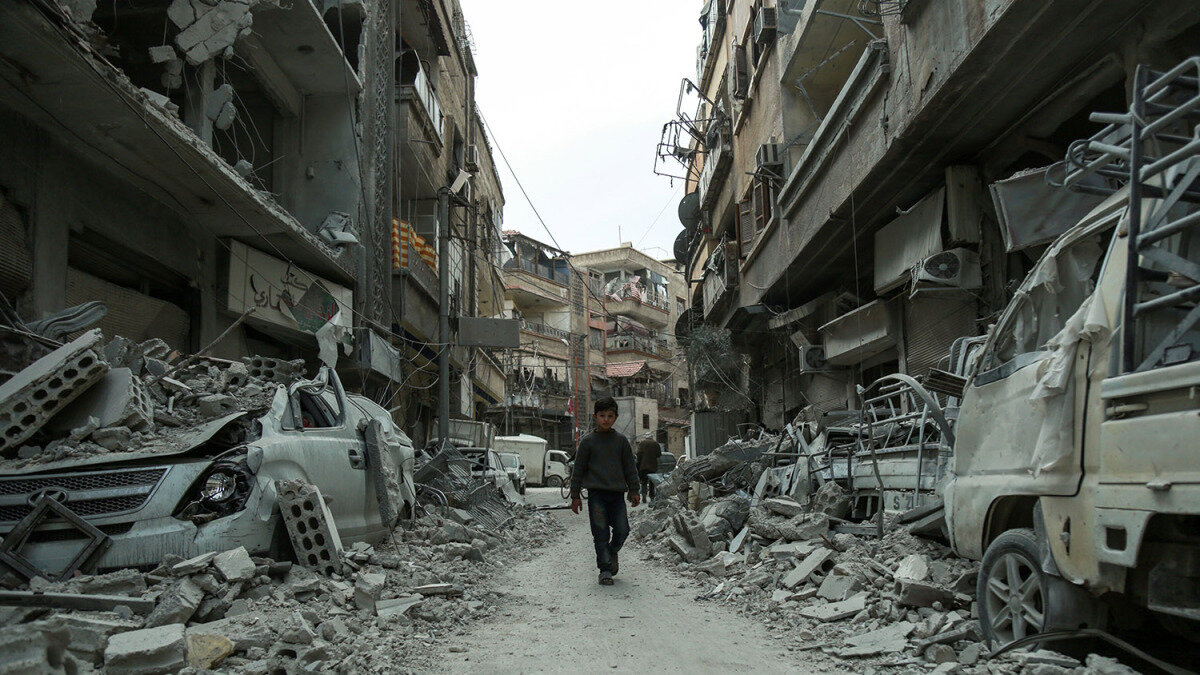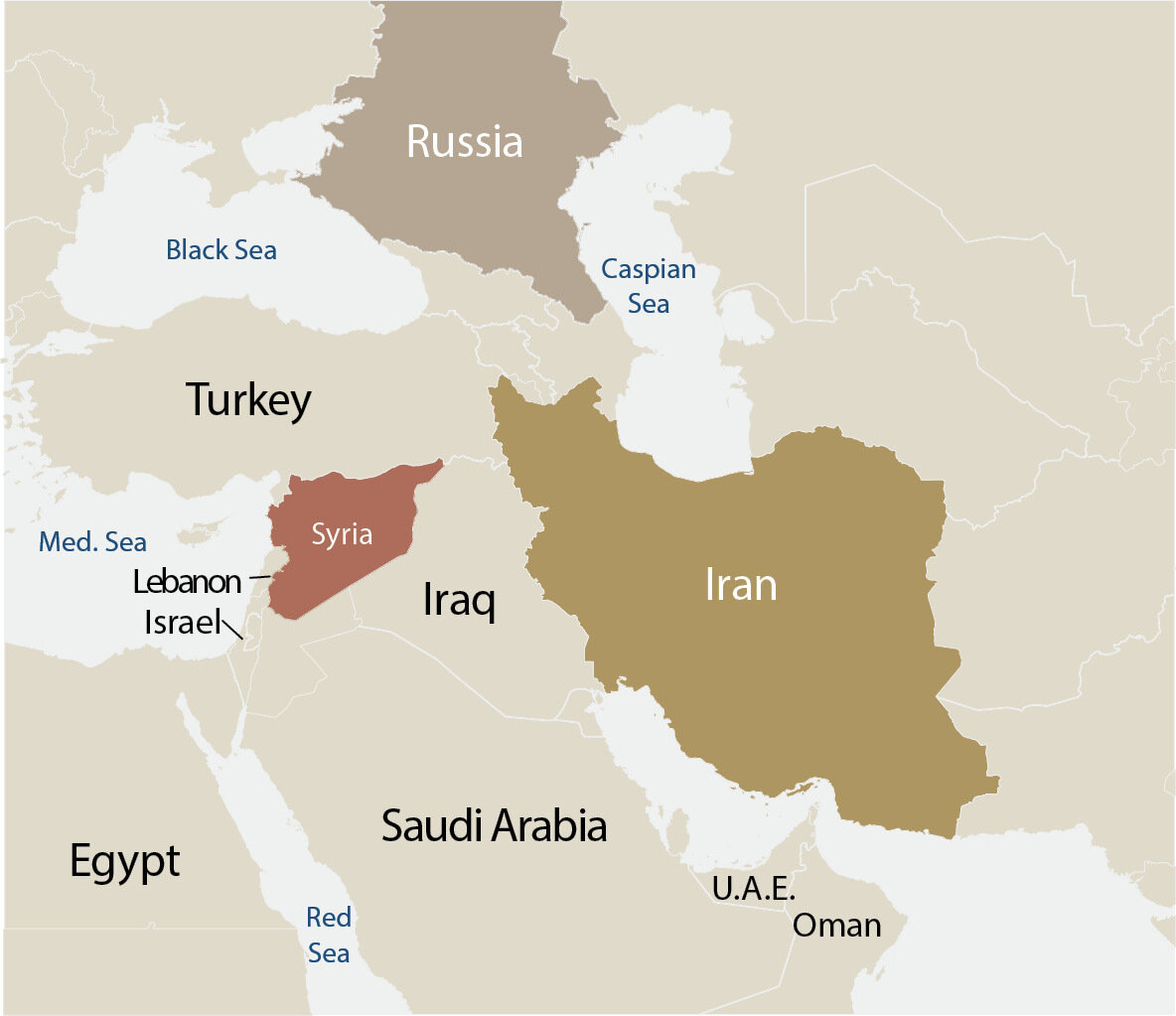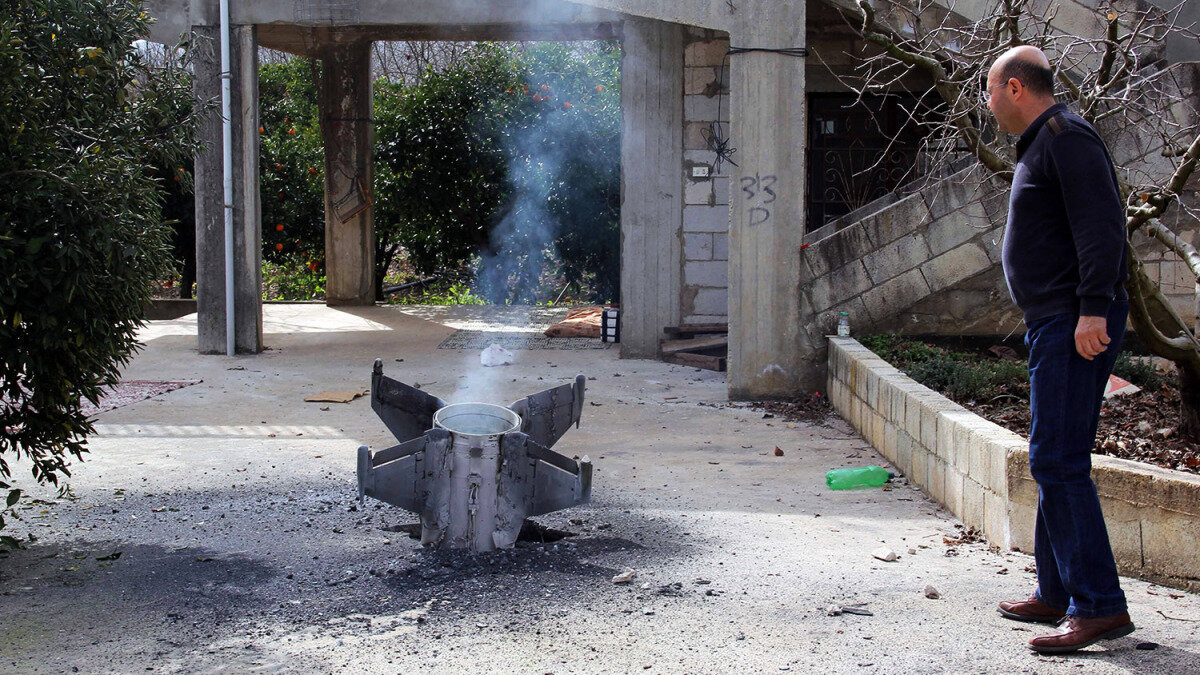The Imminent Iran-Syria Divorce
In July 2015, Iran made a risky decision involving Syria. Up to that point, already four years into the civil war, it had sustained the regime of its ally, Syrian President Bashar Assad, largely by itself. It had ordered thousands of its Hezbollah fighters in southern Lebanon to cross the mountains into Syria. It sent Shiite mercenaries from Afghanistan and Pakistan by the tens of thousands. And the massive conscription of Syrian men was funded, in part, by Iranian cash. Assad seemed to owe his regime, his life and his allegiance to Iran.
Despite Iran’s best efforts, however, Assad continued to lose territory and control. The rise of the Islamic State in the southeast, the dominance of the American-backed Kurds in the northeast, and the determination of the Syrian rebels in the populated areas of the north and west, meant that Assad controlled only 25 percent of Syria’s territory.
In this dire situation, Islamic Revolutionary Guard Corps’ Quds Force Cmdr. Qassem Suleimani was spotted. Visiting Syria to assess matters, he concluded that, to preserve Assad’s regime, Iran needed more help.
Immediately afterward, Suleimani met Russian President Vladimir Putin in Moscow. He reportedly laid a map of Syria on the table and explained the need for Russian airpower to preserve not only Iran’s assets in Syria, but also Russia’s. Syria is a longtime ally of Russia, and hosts the only Russian naval base on the Mediterranean Sea.
Putin did not need much convincing. Eager to restore Russia to the glory of its Soviet era, he relished the prospect of returning to the Middle East.
In September 2015, Russian forces were spotted in Syria, and it wasn’t long before Russian jets were crisscrossing Syrian airspace.
Inviting Russia into Syria was a risky move for Tehran, and today the reason why is clear. With the rebels confined to parts of Idlib province and the Islamic State largely vanquished, the future of the Assad regime is “safe for now.” It is time for Assad to repay his benefactors for their service. This means paying Iran and Russia. And doing so in a way satisfactory to both these nations looks increasingly unrealistic, since Russia and Iran have divergent postwar goals.
This situation is illuminating a biblical prophecy the Trumpet has pointed to for two decades. More specifically, for six years, we have repeatedly drawn our readers’ attention to an article titled “How the Syrian Crisis Will End,” in which editor in chief Gerald Flurry prophesied that the Syria-Iran alliance will fracture and that Syria will align with a German-led European force. Today, this prophecy is ripe for fulfillment.
From Allies to Competitors
After almost eight years of war, Syria lies in rubble. Cities such as Aleppo, Raqqa and Homs, once home to hundreds of thousands or millions of people, are shells of their former selves, with entire neighborhoods flattened by the fighting. National infrastructure such as bridges, roads and the power grid urgently need repairs.
The cost of repairing Syria is astronomical. In August, the United Nations estimated that it would cost $400 billion to restore Syria to the point that the millions of displaced Syrians could return. Problem is, Syria lacks the capacity to do the work itself and is going to need outside assistance. Enter Iran and Russia, again. With billions up for grabs, Iran and Russia each want their own companies to receive the reconstruction money the Syrian government will be spending. Whether it’s contracts for the exploration of Syria’s oil fields, control of the massive phosphate mines, electrical plant construction, or control of the future of Syria’s telecom industry, Russia and Iran are petitioning the Assad regime for a share of this economic windfall.

There is also the question of who will give Syria the cash to rebuild. Which nations would be comfortable lining the pockets of the belligerent regime in Tehran or Moscow? Not many.
Today, it appears the Kremlin is realizing that none of that $400 billion will come its way as long as it is partnering with the Iranians.
Why Does Iran Care About Syria?
For 20 years, the Trumpet has followed Iran’s rise in the Middle East. Iran’s clear ambition is to rule the region. The nation’s policy on Syria and its support for the Assad regime should be viewed in this light.
Iran’s strategy is to control the Shia Crescent, the vast swath of land that arches from Iran and Iraq in the east, through to Syria and Lebanon on the Mediterranean coast. This area includes substantial populations that practice Shiite Islam, a religious sect that Iran dominates. Strategically, Iran needs to control this territory in order to project power into the Mediterranean and to threaten Israel.
To control this region, Iran needs influence in Iraq, Syria and Lebanon.
It already controls much of Lebanon through its proxy Hezbollah. In Iraq, it holds several advantages: Shiite militias loyal to Iran vanquishing the Islamic State; pro-Iranian elements inside the Iraqi government; and numerous western Iraqi border crossings controlled by Shiite elements inside the Iraqi military. Iran can operate relatively freely within Iraq.

However, nestled between Iraq and Lebanon is Syria. To complete the Shia Crescent, Iran needs to preserve its influence over the regime of Assad, whose Alawite faith is an offshoot of Shia Islam.
This is why, when Assad’s position was threatened by the majority Sunni population during Syria’s civil war, Iran devoted massive resources to protect and preserve him. It sent tens of thousands of Shiite militia fighters to preserve Assad—fully intending to stay there and dictate policy inside Syria once the war ended.
If Iran had been able to accomplish this without help from Russia, the Middle East today would be even more dangerous. Tehran would control virtually the entire stretch of land from Pakistan to the Mediterranean.
Instead, Iran must now give way to Russia, thus complicating its own plans. Russia might have tolerated Iranian dominance of postwar Syria if both parties had received a generous share of the lucrative reconstruction contracts. However, the Russians see the very prospect of peace in Syria, and hence the chance to profit off the rebuilding, slipping away: Iran has started to use its presence within the nation in its ongoing war against Israel.
Israel’s Role
Since the start of 2016, Israel has fired more than 800 missiles and mortar shells into Syria and struck more than 200 military targets. The targets are mostly weapons depots and arms convoys used by Iran to defend the Assad regime and support Shiite militias in the region, including Hezbollah.
Israel has repeatedly said that it will not allow Iran to establish a threatening presence inside Syria, nor transfer advanced missiles to Hezbollah. Its military strikes on Iranian assets show that it is prepared to back words with actions.
If Iran continues to be aggressive against Israel via Syria, Israel will keep counterattacking. This threatens to further destabilize Syria, perpetuating the war. The United States and other countries are refusing to supply reconstruction aid unless Iran withdraws. Russia would likely accept Iran’s postwar presence in Syria if the reconstruction money came in, but that is looking less likely by the day. On October 10, U.S. Secretary of State Mike Pompeo said, “If Syria doesn’t ensure the total withdrawal of Iranian-backed troops, it will not receive one single dollar from the United States for reconstruction.”
Iranian journalist and Middle East observer Habib Hosseinifard told Deutsche Welle earlier this year, “For the U.S. and Israel, the withdrawal of Iran from Syria is a primary condition for financial assistance, along with the restoration of the country’s sovereignty.” He continued, “For the West to be ready to support Syria and enable the return of refugees, Syria will first have to change its Iran policy” (September 6).
In recent conversations with German Chancellor Angela Merkel, President Putin stressed that the way to ease the migration crisis in Europe is to fund the reconstruction of Syria. Faisal al-Yafai wrote in the National on August 21, “This is the central argument of Mr. Putin’s new strategy: that without money to rebuild Syria, millions of refugees cannot go home. It is a message he knows will be heard attentively in the Middle Eastern and European countries that have borne the brunt of the refugee crisis.” However, Europe seems uninterested, at least until there is a political solution in Syria.

With Europe and the U.S. unwilling to fund reconstruction, and with Iran continuing to create instability and conflict in Syria, there are signs that Russia and Syria may try to sideline Iran.
Cracks in the Syrian-Iranian relationship have already formed. In September, local media reported on Syrian forces coming into direct conflict with pro-Iran Shiite militias in eastern Syria. Numerous casualties were reported on both sides as they fought over a key township near the Iraq border—a border crossing necessary for Iran to control land routes to Lebanon. This was the first time these “allies” were seen fighting each other.
Some Iranian legislators are expressing concerns that Assad and Russia might be planning to sideline Iran. “Bashar al-Assad, with full impudence, has cozied up to Putin,” Iranian M.P. Behrouz Bonyadi told Radio Farda in June. “Russia will not be a trustworthy friend for us.”
Assad has a choice. He can be an Iranian stooge and be considered a pariah by other nations. Or he can more or less side with the rest of the world. Unlike many of the other groups under Iran’s religious sway, Syria’s Alawites do not follow in the same fanatical ideas and could be induced to change allegiances.
While it is difficult to see how the Iranians will leave, given how entrenched they are in Syria, it looks likelier now than ever.
One reason that this prospect is so important to watch for is that the Bible indicates it will happen—and soon!
Bible Prophecy Provides Clarity
The various factors at work in Syria make it a complex issue to understand. However, as astounding as this may sound, Bible prophecies actually reveal what will happen in Syria. We can understand by studying two biblical passages that relate to two critical Middle Eastern end-time alliances.
The first is Daniel 11:40. For more than 25 years, the Trumpet has explained that this “king of the south” is radical Islam, led by Iran. This Islamist alliance will include Iraq, as well as nations along the western coastline of the Red Sea and the southern Mediterranean, including Egypt, Ethiopia, Eritrea and Libya.
Note, however, that Syria is not listed in this prophesied Iran-led alliance.
Instead, Syria is grouped in the other alliance of Middle Eastern nations, described in Psalm 83: “For they have consulted together with one consent: they are confederate against thee: The tabernacles of Edom, and the Ishmaelites; of Moab, and the Hagarenes; Gebal, and Ammon, and Amalek; the Philistines with the inhabitants of Tyre; Assur also is joined with them …” (verses 5-8). As any Bible commentary will tell you, an alliance of these countries has never existed in history.
This alliance between certain Middle Eastern nations and Germany (Assur) will develop in the end time.
One of the nations mentioned, the Hagarenes, corresponds to modern Syria. In many ways, the Psalm 83 alliance is an anti-Iranian alliance.
https://www.youtube.com/watch?v=qJGLSAoNhLQ&index=6&list=PLrKBlesm40fL_tJlfXnoyX8wbSE-YAxTI&t=2s
Based on these end-time prophecies, the Trumpet has forecast for two decades that Syria’s alliance with Iran is destined to end. But given how critical Syria is to Iran for establishing the Shia Crescent, it also seems that losing it will affect Iran’s ability to maintain control in Lebanon and its access to the eastern Mediterranean.
Lebanon—specifically southern Lebanon, where Iran currently has much support through Hezbollah—is also destined to be part of the Psalm 83 alliance, not the Iranian-led king of the south.
Furthermore, with Iran’s access to the eastern Mediterranean cut off, Iran could redirect more attention on its strategy to control the nations along the Red Sea and into Egypt, which will give it Mediterranean access from the south. Based on Daniel 11:40-43, we know those nations will be allied with Iran.
Mr. Flurry alluded to such dramatic geopolitical shifts in “How the Syrian Crisis Will End” at the very outset of the war. He wrote: “What we are seeing right now in Syria is a major biblical prophecy in the process of being fulfilled! What happens in Syria will lead to mighty nations changing course and the foundations of this world being shaken!” (September 2012).
Surely we have seen that happen already. Events in Syria have led to the largest mass migration into Europe in human history. In turn, this has reshaped modern Europe. Its long-held ardor for multiculturalism is giving way to rising nationalism; its post-world war stability has been replaced by a climate where strongmen are elected to preserve Europe from outsiders. All this is prophesied elsewhere in the Bible.
And now, the outcome of the Syrian civil war will only further encourage Europe to direct its resources to the southern Mediterranean, which is what Daniel 11:40-43 describe. This is a critical development to watch for, because it is a signpost of where we are in Bible prophecy. As the next few verses in Daniel relate, it leads directly to the Second Coming of the Messiah, when such destructive alliances between worldly nations will end, and be replaced by an era of eternal righteous rule the world over.
